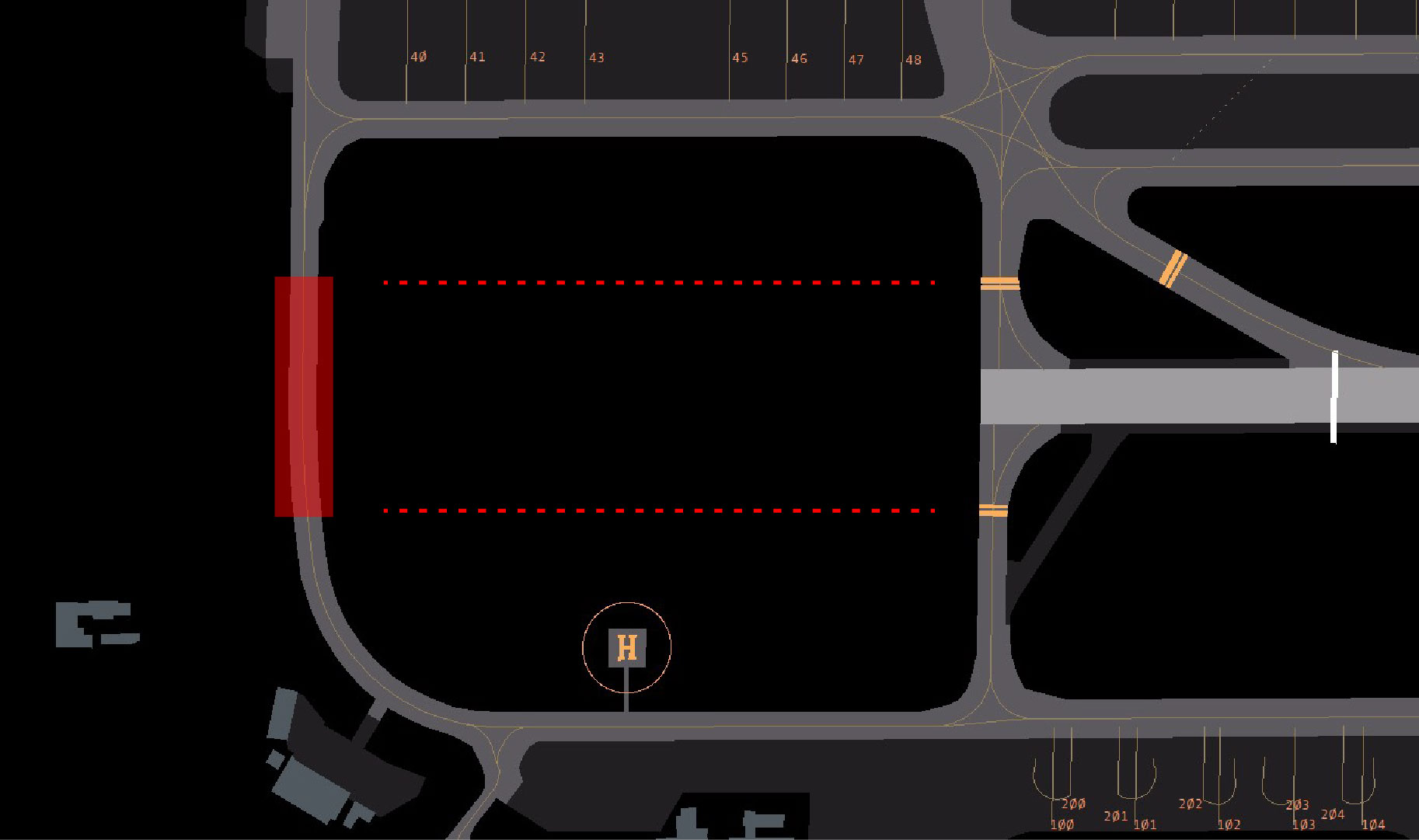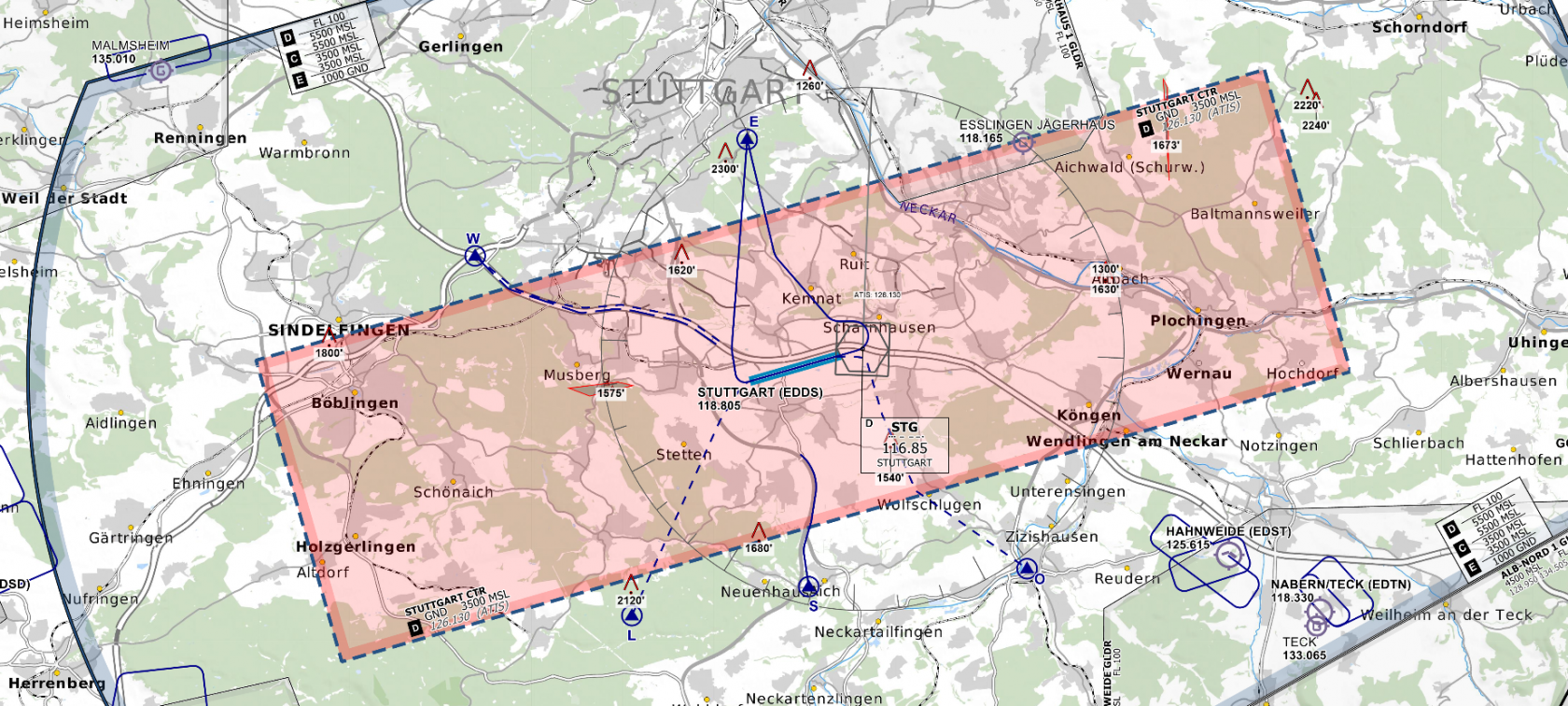Tower
Stuttgart Tower is responsible for the runway and traffic within the Stuttgart CTR.
Please also check the EDDS Arrival SOP to familiarize yourself with Arrival procedures relevant for Tower operations to enable the necessary coordination with Approach.
General
Operating direction
Runway in use is based on the direction of the wind (METAR and TAF) and general weather conditions. While there is technically no preferred runway direction at Stuttgart, 25 is normally used whenever conditions allow.
Taxiway Z
Taxiway Z is controlled by Ground. To avoid low altitude overflights on short final during 07 operations and ILS interference during 25 operations, crossings of some high aircraft on Z between O and R require approval by Tower to cross the extended centerline according to the rules below. Ground has to inform Tower of crossings that don't require approval as well. If the restrictions are not met, the aircraft on final has to go around.
| Height |
Restriction |
| 07 operations |
|
| any |
sensitive area has to be clear when traffic is within 2 NM final |
| 25 operations | |
| > 14 m (CAT1) |
traffic must be able to proceed without ILS guidance within 4 NM final |
| > 6 m (LVP) | sensitive area has to be clear when traffic is within 4 NM final |

the sensitive area (red) can be estimated in extension of the holding points
Additionally, during 25 operations, Tower shall inform aircraft on final about potential ILS interference from crossings on Z that require approval.
ATC: Lufthansa 123, expect short term ILS interference by Airbus A320 crossing on Z.
Reduced runway separation
RRS minima may be applied by Stuttgart Tower, according to the following table:
| Runway |
preceding CAT 1/CAT 2 succeeding CAT 1 |
preceding CAT 1/CAT 2 succeeding CAT 2 |
preceding CAT 3 succeeding CAT 1/CAT 2/CAT 3
|
| 07/25 | 600m | 1500m | 2400m |
Outbound Traffic
Intersection Departures
Pilots always need to be asked if they are able for any intersection except full length. Smaller aircraft are usually sent to intersection C (25 operations) or G (07 operations).
Bypass Area
If outbound traffic is not ready for departure, it can wait at bypass area P1 or P2 (max. B739/A321). The bypass area also makes it possible to change the departure sequence when the preceding traffic is instructed to hold short of S and the succeeding traffic to taxi to the holding point via P1 or P2 and S.
Separation
Stuttgart Tower is responsible for separation until the aircraft reaches the initial climb altitude.
During 07 operations, special attention must be paid to aircraft on K-SIDs departing after traffic on a H-SID that also makes a right turn to the West after takeoff (ROTWE, STG, SUL, and TEDGO). To ensure separation, Tower has two options:
- departure release by the appropriate Langen Radar sector
- guaranteed minimum 1000ft vertical separation (e.g. due to climb rate or if the H-SID reaches FL60 before the K-SID reaches 4000ft)
Opposite Departures
Departures against the current operating direction always require a departure release by Stuttgart Director (DSAT), if online, and otherwise by Langen Radar (STG).
A rule of thumb for when such a release can usually be expected is when the next inbound is at least 20 NM from touchdown. Due to other factors, a release might still be granted later or not anymore, though.
Visual Departures
To increase efficiency, Tower can utilize visual departures for prop and turboprop aircraft up to 5.7t MTOM. These have to be coordinated with Arrival and accepted by the pilot. Separation always has to be ensured.
ATC: DEABC, advise able to accept visual departure.ATC: DEABC, when airborne turn right heading 340, maintain visual reference to the terrain until passing 3500ft, climb 5000ft, remain on tower frequency.
| SID | Heading |
| 07 North |
350 |
| 07 South |
160 |
| 25 North |
340 |
| 25 South |
200 |
The handoff to Arrival takes place when the aircraft has passed the MVA.
Inbound Traffic
Vacating Traffic
Tower shall give the initial turn onto taxiway N or S when vacating. This will ensure an efficient traffic flow and prevent blocking the runway exits with traffic holding during the frequency change. The handoff should take place after the instruction to turn on N or S.
Missed Approaches
By default missed approaches are flown as published, deviations are only possible if necessary to ensure separation and Arrival has to be informed as soon as possible. Once separation is ensured the aircraft is handed off to Stuttgart Director (DSAT) if online, and otherwise to Langen Radar (STG).
After a missed approach, the next IFR departure requires a departure release.
VFR Traffic

Stuttgart Controlzone (D-CTR) - © openflightmaps.org
Stuttgart has a D-CTR from GND to 3500 feet AMSL. VFR traffic circuits can be flown North and South of the airport.
Reporting points
The following mandatory reporting points exist around the airport:
| Reporting point |
Location |
| W |
highway intersection A8 and A81 |
| E |
between Fernsehturm Stuttgart and Fernmeldeturm Stuttgart |
| L |
Fernmeldeturm Waldenbuch/Dettenhausen |
| S |
Aichtalviadukt (B27) |
| O |
Neckarbrücke Nürtingen |
VFR Tower
Stuttgart has a VFR Tower that is responsible for incoming VFR traffic. If this position is staffed, VFR pilots entering the CTR initially contact this controller. The VFR Tower will then give instructions on how to enter the CTR as well as inform the pilot about the QNH and the active runway. The pilots are then handed off and instructed to report the mandatory reporting point to Stuttgart Tower (DST) who is then responsible for all further instructions.
After coordination with Tower, traffic only crossing the CTR may remain on the VFR Tower frequency.
VFR Tower has to keep a close eye on the general traffic situation to gauge which VFR requests can be accommodated and when VFR inbounds have to be delayed.
SVFR
The maximum altitude for SVFR traffic within the CTR is 3000ft AMSL.
Helicopter Operation
Stuttgart has two helipads. Helipad North is located south of taxiway S, between taxiway F and taxiway E. Helipad South is located west of the threshold of runway 07 and north of the military apron. Helicopters must use the helipads or the runway for takeoff/landing.
Auto-Handoff
Stuttgart utilizes an auto-handoff procedure for IFR departures where Tower will not hand off outbounds to the approach controller. Make sure to set the correct departure frequency in the ATIS.
Outbounds should contact APP immediately when airborne unless explicitly told to remain on Tower frequency.
